A play complex for cats is considered the most attractive place where a pet can play and relax at the same time.
Within a few meters, you can place important parts of the house for your cat - a playground, a scratching post, elements for maintaining an active lifestyle. You can make it do it yourself from available materials, without violating the integrity of the structure. Drawings and basic parameters for creating a cat house will be presented approximately.
Types of Animal Houses
A cat house can be more than just a bed. Often, owners of purebred pets live in small apartments, which does not allow for large playpens and enclosures.
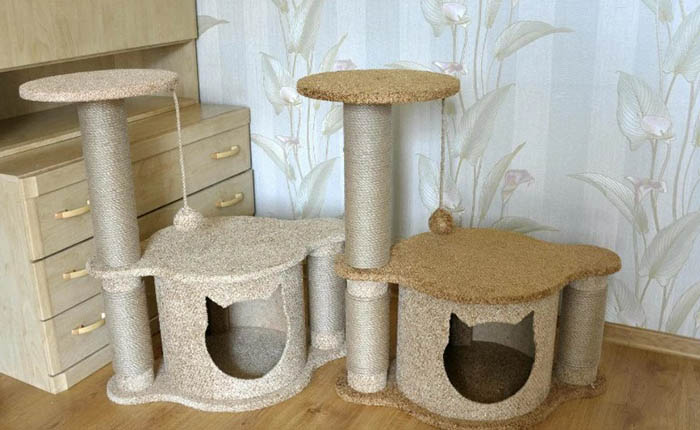
In this regard, the owner of the apartment is interested in the house taking up little space, but being multifunctional and useful.
Cats are not always willing to exchange beds for play complexes, and simple bags for a worthy multi-level replacement. In order for the pet to accept such a gift, you need to please it by making a playhouse according to technical rules.
This will help keep the animal active, giving it pleasure during the time spent there.
- Floor standing design allows the cat to easily get inside the house. It is convenient because it is suitable for large and small breeds of all ages. As the body weight increases, the cat will be able to climb the fastenings to the roof of the play complex. The structure is quite stable, so it can consist of several floors.
- Wall complex – part of the play area where the cat can spend active time with benefit. The elements are attached to wall mounts, taking into account the weight of the pet, reinforced elements of the structure are selected. Hanging houses can be replaced with play shelves, but the house will technically be located separately.
- Spatial complex is presented in the form of mixed structures of horizontal and vertical arrangement.
The most popular option for a cat house is a floor structure. Its plan allows you to change, add or expand the play area. Additionally, frames, pipes, frameless beds, deep beds, and rest areas are made.
Requirements for a cat complex
A DIY play complex for cats can be made from available materials. Developing a plan for creating a play complex begins with drawing up technical specifications for all elements. It is important to pay attention to the choice of materials - environmental friendliness, safety, strength and durability.
It is also important to understand the needs of your pets and to take care of maintaining and developing their play skills.
- The bed cannot be located below the level of 0.4 m. The cat's usual living height should not be violated or neglected due to the health of the pet.
- The area of the base must exceed the area of the entire complex. For safety and stability of the structure, it is recommended to increase this parameter by 20%.
- A scratching post is a must-have item in a cat's home. It should be located closer to the floor so that the pet can easily sharpen its claws.
- Bridges and ladders can be adjacent to the base or other vertical surface. If the jump is unsuccessful, the pet may fall, so it is advisable to place such an element at a high level - this will give the cat time to turn over in the air on all four paws.
- The upholstery should be removable. If the play complex was purchased separately for additional equipment, it is worth taking care of sewing covers. Soft fabric that can be washed will be an excellent reason to choose it.
- Plastic pipes should be between 50 and 120 mm in diameter.
- Chipboard sheets, furniture boards or plywood sheets must be strong, 20-30 mm thick.
- Soft foam pads cannot be thinner than 20 mm.
- It is advisable to choose a cord for a scratching post with a cross-section diameter of at least 10 mm.
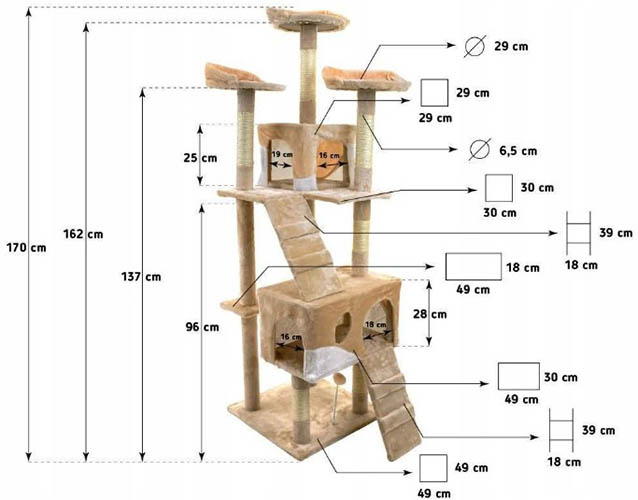
Materials made of natural fiber are considered optimal for cats of any breed. They are more expensive, but meet safety requirements. A furry four-legged friend with an inquisitive nature will study and try all the details of the play complex, so it is worth taking care of the choice of fasteners and house parts.
What tools and materials will be needed?
To create a gaming complex You will need blanks, fastening elements, electromechanical tools and decorative textile material:
| Consumables | Chipboard sheets, construction glue, plastic polymer pipes | Can be replaced with plywood, chipboard, or cardboard sheets. |
| Fastenings | Nails, screws, self-tapping screws | You may need fasteners to secure the furniture together. |
| Tools | Hammer, pliers, sandpaper | You may need a jigsaw. |
| Elements | Carpet or textile, jute rope, foam rubber | An analogue is pressed cellulose impregnated with non-toxic glue. |
| Technique | Screwdriver, furniture stapler, screwdriver, scissors | Alternatively, you can use a drill and hacksaw. |
As auxiliary elements, you may need such individual elements as:
- pillars;
- hammocks;
- shelves;
- gutters;
- tunnels;
- ropes;
- stairs;
- slides.
A DIY play complex for cats can be made from several elements, combining them by height and complexity. The house can be multi-tiered, which allows you to cover a maximum of different play areas.
For ease of planning, you can use ready-made technical illustrations to edit your own house based on them.
Options for cardboard complexes
The most accessible material is considered to be corrugated cardboard. It has increased strength due to the stiffening ribs. Interior items for owners of small apartments are made of cardboard. A sheet of thick cardboard can withstand up to 70 kg of live weight, so there is no need to worry about the safety of the cat's home.
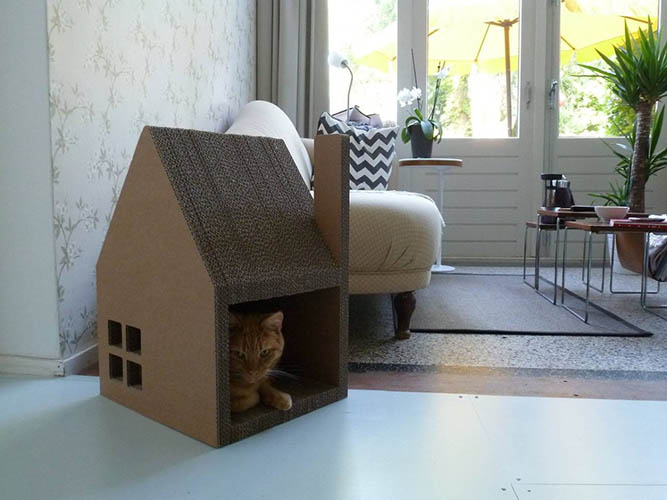
To make a house you will need:
- Corrugated cardboard sheets 100*80 cm or boxes. They need to be arranged to simulate the desired structure.
- Since cardboard is considered a good insulator, you need to lay several sheets on the bottom of the house. You should cut 3-4 parts along the perimeter and glue them together.
- To form the second floor, you need to make a frame to which the floor will be attached. To do this, you need to cut out a part whose dimensions will be 3 cm larger than the base of the first floor.
- For convenience, it is necessary to make a hole in the intermediate part of the frame so that its dimensions are 3 cm smaller than the base.
- The second floor should be made the same as the first, taking into account the height of the house.
- Once the plan is drawn up, you can begin assembling the house and decorating it.
- You can use cardboard boxes as a basis if their dimensions are already suitable for the project.
- Windows and doors need to be made on the front sides of the future house so that the cat can freely enter inside.
- The structure can be strengthened by using a double layer, but this can only be done by carefully gluing each part.
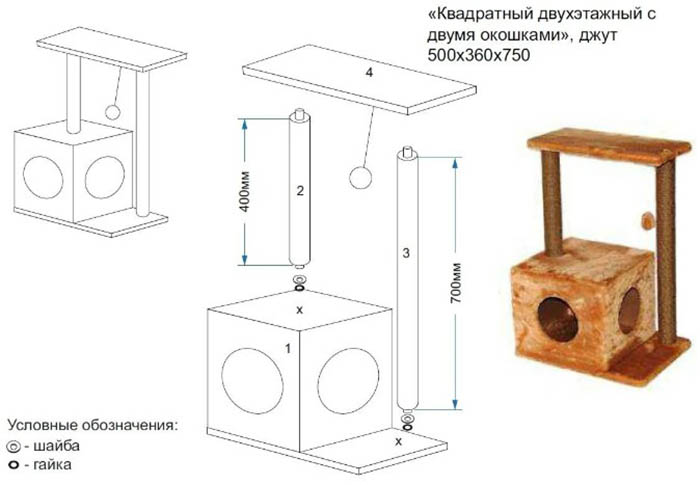
If desired, you can use the diagram to create a large cardboard house from ready-made blanks. Due to the presence of stiffening ribs, the cardboard sheets can be easily folded or formed into a semicircle. Such houses are ideal for small cats or kittens weighing up to 7-10 kg.
A DIY play complex for cats can be made from one tier, supplemented with playgrounds. This is convenient because it does not require additional reinforcement of the walls and frame. Such a house can be supplemented with a scratching post by wrapping the chimney with a rope cord.
To create a one-story house from cardboard you will need:
- From 30 sheets of cardboard you need to prepare the parts - side parts, base and roof.
- You need to draw a diagram of the house in a plane 60 cm wide and 110 cm high, taking into account the roof. You will need 4 of these parts on each side.
- One of the sides can be made with a chimney by adding a rectangle to the drawing diagram with a height equal to the height of the parts and a width of 6-8 cm.
- Between the side parts, you need to make a roof and base gasket. To do this, measure the required height for the roof from the main part and prepare the remaining sheets for cutting and gluing all the parts.
- For the base, you need to make the same number of parts as for the roof. The height of the base should be at least 5-6 cm, the width will correspond to the width of the side parts.
- In order for the house to have three walls, the roof should be made with a spare part, initially measured on the drawing diagram. Its thickness can be up to 4 cm.
- Next, you need to assemble all the parts and glue each layer.
- When the house is ready, it needs to be placed under a press.
- After 24 hours, you can decorate the cat's house and lay a rug for your pet.
A DIY play complex for cats can be made in any size. Each house can be supplemented with a scratching post, which can be easily assembled from a cardboard tube and a cord. Multi-story complexes are best built from dense and stable materials.
A plywood sheet, chipboard or reinforced cardboard sheet will do. Before choosing a material, you need to study the features of working with it. You may need additional tools and equipment.
Made of plywood
Approximate schemes and standard projects of large and spacious houses for cats can be found on the Internet, and you can also draw up a scheme yourself, taking into account the desired type of construction, the general plan of the interior and how the future house can be attached to the wall.
The layout of an apartment does not always allow for the placement of a fairly large object so that it does not interfere with residents and is freely accessible to pets.

To make such play complexes you will need a lot of different materials, equipment and the ability to work with them:
- Polymer pipes of different diameters for creating scratching posts. It is advisable to find pipes at least 2 m long and 10 cm in cross-section. Smaller pipes, for example, 4-5 cm, are suitable for placing scratching posts on the upper floors. Their height should not exceed 1 m.
- A hemp rope or a tourniquet will serve as a winding for the future scratching post. It is best to choose a twisted rope or twine consisting of 3 dense intertwined threads. For 1-2 scratching posts of different diameters, you will need at least 25 m.
- Jute twine for twisting scratching posts - up to 20 m will be needed, so it is recommended to purchase it in the form of bobbins.
- Metal consoles measuring 10*15 cm are required for fasteners.
- Plywood sheets 10 mm thick and 1200*800 mm in size – 2 pcs. for a small house. When constructing a plan for several floors, you need to proceed from the calculation of 3 sheets per floor, taking into account the ceilings.
- A 4 m wide roll of carpet with a dense high pile will be needed for upholstery. It is worth paying attention to the base - a rubberized bottom, like that of car mats, will not work, as it will not attach well to the plywood sheet. It is better to give preference to a polyurethane textured coating, which does not slip and has high adhesion.
- Fasteners - screws, furniture corners and wood glue will be needed in abundance.
- Plastic buckets are needed to make beds; 10-12 liters of capacity are suitable.
- Tools for working with fasteners, screws - a screwdriver or a screwdriver. To cut plywood sheets, you need to buy an electric jigsaw.
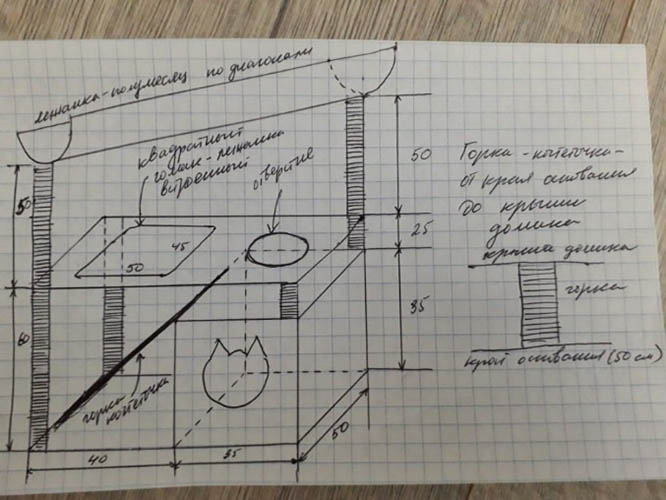
To design a plan, it is necessary to determine at what level the floors will be located, what size the holes will be for installing polymer pipes.
Their dimensions must match the diameter of the pipe cross-section.
- It is necessary to prepare plywood sheets for forming platforms. According to approximate schemes, the dimensions can reach half a meter or more.
- The shelves need to be wrapped with fabric or covered with carpet. When working with fabric, you need foam rubber for padding. The material should be fastened with a furniture stapler.
- The fabric can be attached with construction or universal glue, and the carpet can be attached with staples.
- PVC pipes should be wrapped with bundles before they are installed in the grooves of the platforms. The rope should be attached with glue, and its edges with screws to the base of the pipe.
- Buckets can be used as beds or made into a tunnel by cutting off the bottom and covering the plastic with soft fabric.
- When all the parts of the play complex are ready, they need to be fastened together using construction tools and fasteners.
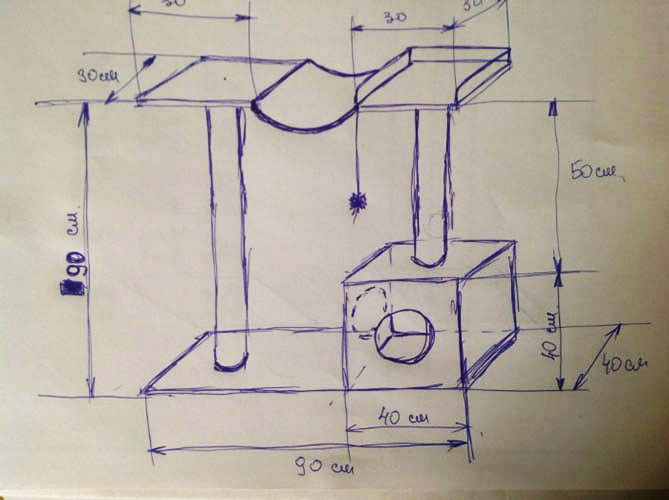
The play complex for cats can be decorated and supplemented with various toys. The design created with your own hands will definitely please not only family members, but also pets. The upholstery can be cleaned if desired. To make a removable soft part, you need to sew covers separately, taking into account the size of the house and each detail, in particular.
It is advisable to attach the finished structure to the wall so that it does not accidentally fall due to the pet’s activity.
Construction with scratching post
There are play complexes, the basis of which is a high large scratching post. This model is suitable for those who have several cats of different ages and temperaments in the house. The main central element is a pipe, which is complemented by various shelves and sleeping areas.

There are also wall platforms that you can make yourself:
- For the work you will need chipboard sheets at least 5 cm thick. They can be replaced with small pallets, wooden boxes or plastic containers.
- Fasteners – you will need 8 and 10 mm self-tapping screws up to 6 mm wide.
- A plastic pipe at least 2 m high – it will serve as a scratching post.
- Fabric and rope to wrap around the pipe and create a scratching post.
- A screwdriver, glue and furniture corners are needed to attach the shelves and install the scratching post.
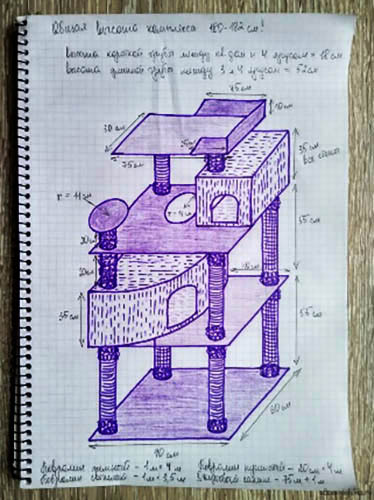
First, you need to place and mark the places where the shelves in the form of boxes or plywood will be located on the wall.
It is necessary to drill holes and lay dowels in advance.
- The boxes located on the wall must be secured with screws. The parts must be firmly secured with a corner and spacer metal ties.
- A plastic pipe can be installed on a plywood base using furniture corners and self-tapping screws.
- The rope needs to be wrapped around the pipe and the ends secured using a furniture stapler.
- Next, you need to install the substrate near the wall, and then screw the pipe onto the bundle or tightly using the corners at a level of 1 m.
- If desired, the pipe can be supplemented by installing an upper platform.
A DIY play complex for cats should be made from well-treated wood. Wooden boxes should preferably be covered with fabric or sanded well so that pets do not get hurt. Plastic boxes can be covered with a fixed fabric backing. If desired, you can imitate wood from a pipe by connecting several elements using rings.
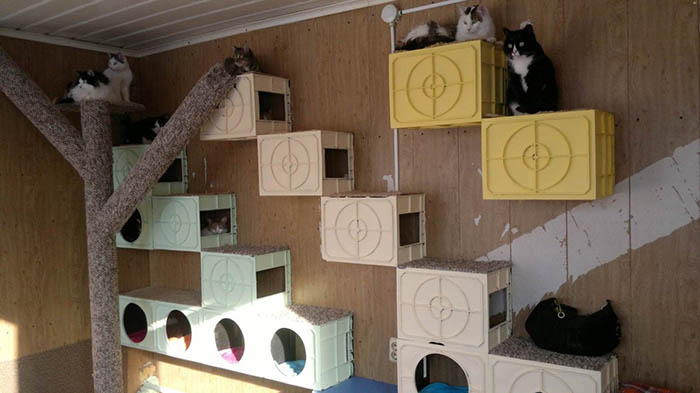
You can also get by with just shelves made of thick fabric. Thanks to the tension and secure fastening, such wall-mounted beds remain durable and safe for pets.
Cats will be interested in climbing on the scratching post, jumping onto the upper shelves and overcoming obstacles. Such a complex looks minimalistic, combining all the details of the aspects of the active life of cats.
Decorating ideas
Since play complexes combine not only a recreation area, but also places for active games of pets, you can use as decoration those elements that will arouse genuine interest in cats.
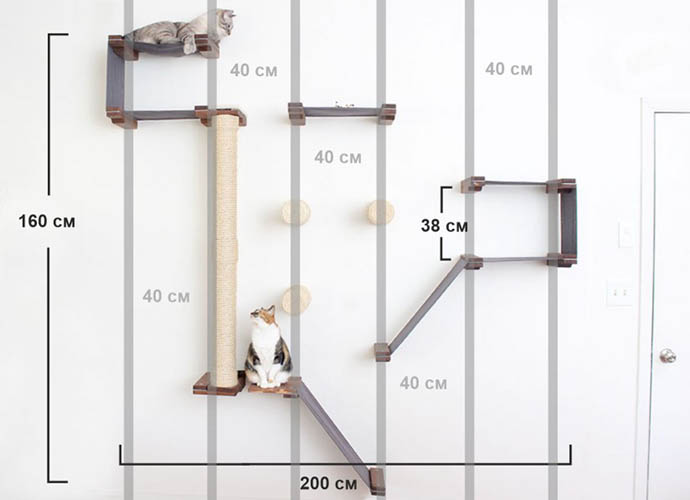
They are most attracted to:
- feather fillers;
- ringing elements;
- spinning toys;
- harness mice;
- soft balls;
- toys dangling in the air;
- hanging spring trifles.
Such toys can be fixed to the edges of the platforms so that the pet can reach them from the lower tiers. Of greater interest are models of toys that move when touched. These can be canes that have toys tied to one end.
Spring parts are interesting for cats who prefer to be on the first tiers. Floor inventions are convenient for cats who know how to occupy themselves with play.
Play complexes for cats are now presented in a large assortment. If you have inexpensive models, you can buy a house and add play areas to it with your own hands.
If for some reason this is impossible, it is enough to draw up a plan diagram and build a house from scrap materials. The availability of this method allows not only to make a playground, but also to implement the plan, saving a considerable amount.
Video about the play complex for cats
